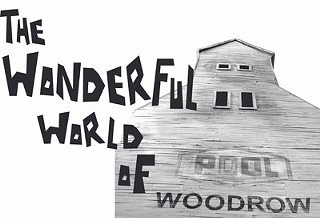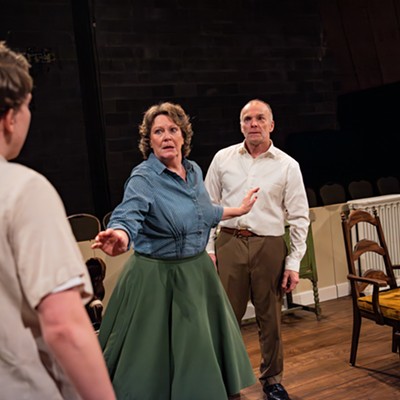It’s one week before Graeme Patterson’s exhibition Woodrow opens at the Art Gallery of Nova Scotia and there’s fresh paint on the walls. A black sky and twinkling stars float above a yellow field, suggesting the moon’s glow on a warm prairie night. Piano-sized wooden crates, scattered along the edges of the room, reveal nine sculptural and video works, each representing a physical or fictional element from the small farming village of Woodrow in southwestern Saskatchewan. Looking around, there are a small barn, a house and workshop, a church and a hockey rink—all are table-sized, perfect for small dolls or large rodents. A group of deer, whose alien eyes glow from unseen lights, circles a tree. The grain elevator hasn’t arrived yet though, and the giant junk pit is still waiting to be filled.
The real Woodrow, with a population of under 20 today, is where Patterson lives and works. His great-grandparents homesteaded there and his great-grandfather helped build much of the town with his own hands. His grandfather, Herbert, was born on the kitchen table of the house. And his family’s pride still radiates from this modest place, which has sustained itself for several generations unbeknownst to most Canadians. It’s where Patterson, growing up in Saskatoon, spent his summers and holidays. A kid, who, by his own account, started experimenting with animation early on, turning his basement into a giant Ninja Turtle fortress. Now, Patterson has combined a natural storytelling heritage with sculpture, stop-motion animation, electronics and audio, to build one of the most heartfelt and delightful contemporary exhibitions any Canadian small town could wish for. Welcome to Woodrow.
Patterson, whose slight frame and wide eyes also beg to be animated, peers inside the graying barn, which is almost two metres long and three wide. Constructed out of painted foamcore and wood, every detail, from the vaulted ceiling to the fraying shingles, is considered. One end of the barn is shaved open to reveal a small stage where the video Romancing the Farm will play. Set to a carnival soundtrack (Patterson also composes and plays all his own music), Romancing is a three-minute stop-action video where both barnyard animals and humans parade in front of the barn stairs. Various men shoot tin cans, rev the ski-doo and brave the winter winds. One shirtless man with an ample belly bangs away on a computer keyboard, dressed only in underwear (the iconic tight blue ones with white piping).
This is the first piece of the series, finished in 2004. Patterson was still living in Halifax after graduating from NSCAD in 2002 with a Bachelor of Fine Arts interdisciplinary degree. Out of familial separation came nostalgia. “It was a romantic vision of how I remembered things and so I started working with this idea of the farm.” Unfortunately, the original barn was crushed in transit en route to a show in Los Angeles. The insurance money from that, serendipitously, funded the move to Woodrow, he says.
He looks inside again—Patterson is sure that the mouse droppings, a reality of farm life, were cleaned out before he left, but he double-checks anyway. However, a small spider and cobwebs did make the cross-country journey on the outside window of the model church, where an animatronic version of his grandmother plays the organ inside. Down below, visible through a hole in the church’s foundations, there’s a video of two old men bowling frames with the same singlemindedness that makes the pious pray upstairs.
Patterson reaches in and turns on an MP3 player, filling the gallery with Danny Elfman-ish organ music.
“I was trying to get my grandmother to play it, but she was too fragile,” he says. “She’s really good, but she’s gotten to the point where she knows she can’t really physically do it. It still sounds good, but she’s just too conscious of playing badly.” In his early animations Patterson tried to find other musicians to compose music for him, but he likes the fact that “everything blends in, that you get a sense it comes from the same person.”
This independence comes naturally. “It’s the way I grew up, doing a lot of things myself. I came from a family that does that. My dad says never call anyone to fix anything.”
Patterson’s aesthetic comes partially out of this DIY process—he’s had to learn to live with the quirky results that come with experimentation.
He walks over to the hockey rink where tough little warriors are frozen on the ice. Larger than your typical table-hockey game, with more character and movement, a video on the scoreboard above shows players from the nearby town of Lafleche battling it out against the Woodrow team—fighting, falling and checking into the boards. The Lafleche players are modelled after a real photo of the 1972 team, but they play against a fictional Woodrow crew. All of them have that ’70s Bobby Orr rugged macho look, in part because no one wears visors and moustaches are de rigueur.
“I always imagined my work as a lot cleaner but then I realized that you get these little surprises from things,” Patterson says, pulling up one scrappy player off the wire and examining his wee body, made out of latex rubber, foam and fabric scraps. “Like with the rubber, it started to bubble a bit after I had done all the detail and formed the head. It forms wrinkles. Look at this guy—it just adds character. They’re grotesque in their own way.”
Although Woodrow is a ghost town—among many of the installation’s sophisticated paradoxes—it’s filled with life, especially in the animation “Monkey and Deer,” where a monkey, like the artist, moves to town, causing disruption. But while it may be inspired by sentimental emotions, this show doesn’t rate on the schlock meter. There’s a darkness in the crumbling buildings and in the giant pothole filled with debris. In the house, which is a model of the home where Patterson now lives, a video of snakes and mice runs through its core. It creaks with age. Not surprisingly, in a country where more than 80 percent of the population lives in urban areas, it’s easy to read a political message about the death of rural Canada. But that’s missing the point.
“Sure, that is what’s happening and why things are falling apart but it’s more trying to show the positive,” says Patterson. “There are still these people who have these stories, and who love their town. That’s why the barn is a romantic vision—an old decaying building, but there’s still a lot of life left. But it’s not supposed to be a political, sentimental or romantic ideal of that.”
While many parts of the exhibition could be considered a physical representation of Patterson’s internal thoughts, the heart of the exhibition, and of Woodrow, is Patterson’s deceased grandfather. In the model of Patterson’s workshop—where tiny models of the exhibition reside among tools and materials—a video of his grandfather’s lathe, running unattended, plays. And he still tosses horseshoes (on video) downstairs in the house.
“He was super-sentimental and really proud of where he came from, of what his father had built, and of what he had built in the town. He was really proud of who he was because of that,” explains Patterson. “And he was a really good storyteller, even though there was a bit of BS in there. At the same time, he was genuine and there was always some sort of meaning he was trying to get across.”
“If he could see the show”—Patterson looks down—“it would be hard to see him because his reaction would be so strong. But in a good way.”
As curator, it’s part of Ray Cronin’s day job to be enthusiastic. But it’s obvious from the way that he speaks about Patterson’s work, and the pleasure he expresses moving around the gallery, that Cronin believes in this young artist. Cronin has followed Patterson since his first major animation, the surreal and lonely Don’t Ride Shopping Carts, which won a most-promising new director award at the 2003 Atlantic Film Festival. In early 2004 he included Patterson in an exhibition of five Nova Scotian artists he was curating at the Beaverbrook Gallery in Fredericton.
“His work always incorporates humour, and a sense of honest interest in history and in place,” says Cronin, listing reasons off on his fingers. “It’s work rooted in a particular way, it’s not ashamed of being a fan of a particular place, it is work that’s as much a homage to his grandparents as it is really smart, postmodern sculpture. And the way that it all ties together, you get something so engaging that works on so many levels, it’s a curator’s dream.”
Cronin isn’t alone. Almost all of the pieces in Woodrow have been acquired by galleries stretching across the country. The National Gallery in Ottawa purchased the Grain Elevator, which makes Patterson the youngest artist ever whose work has been acquired by the institution. The entire installation will appear at the Montreal Biennial this May, and then continue on across the country to six other cities. As accessible as it as complex, Woodrow is expected to appeal to jaded contemporary-art lovers as much as first-time gallery visitors.
“You don’t need an essay to understand this work,” says Cronin. “Everyone that’s been told a story about where they’re from, about their family, about the town they’re from, or has gone back to try to figure these things out, will get this work. It’s universal and about being human, it’s not about art.”
Patterson shrugs off the attention. After touring Canada with the exhibition, he’ll head for Europe, but he’s “a bit bummed out” and worried about being away from his grandmother. And there won’t be much time for the human-sized Woodrow.
“My dad used to tell me that for him, Woodrow was the centre of the universe, and that’s what they thought,” Patterson says. “They had everything there at one point in time. They had their heroes. They made their own music and everything they needed, and it worked.”
Sue Carter Flinn is The Coast’s Special Issues Editor, editor of Visual Arts News—the only magazine dedicated to visual art in Nova Scotia—and Halifax correspondent for the national arts website: www.akimbo.biz
Woodrow, until April 9 at the Art Gallery of Nova Scotia, 1723 Hollis.















